Experimental Research on Hydrodynamic Characteristics of Propeller in Waves
GUO Chun-yu,ZHAO Da-gang,WANG Chao,CHANG Xin
(College of Shipbuilding Engineering,Harbin Engineering University,Harbin 150001,China)
1 Introduction
For a ship sailing in waves,compared with in calm water,the resistance increases and the propulsive performance declines due to the influence of external environment.As a result,the actual speed is lower than the estimation.To the perspective of performance design technique,researches about ship propulsion performance in waves are very necessary.In fact,when a ship sailing in a serious sea conditions or in ballast,the propeller will close to,or even surpass the water surface because of the heave and the pitch of ship.So it has the air-ingestion and even the‘runaway’phenomenon.The result of that is the decline of propeller thrust and efficiency.The worse are the hull vibration and the intense problems of propeller and shafting from the influence of waves force and loading fluctuant changing of blades which exit and entry water periodically.So in recent years,more countries take much more attention to ship propulsive performance in waves.Many countries pay close attention to the rapidity,maneuverability and seakeeping of ship in wind waves.Researches of changing regularity of the propeller hydrodynamic performance are an important aspect of ship rapidity research in waves.When a ship sways in stormy waves,there are six additional hydrodynamic thrust and torque components on propeller.Its operation characteristic changes greatly:the thrust reduces and the torque increases.If measured accurately,it not only can be used as a forecast of resistance increasing and stalling when ship sails in wind waves,but also can be used as a reference to enhance the research of ship rapidity and the propeller designing.
The operational factors and quantitative analysis of propeller in waves are a much newer topic,thus the material is less.The study is mainly divided into two parts:regular waves and irregular waves,and each part includes theory and experiment researches.In theory part,Yuasa et al(1974)[1]regarded blades of propeller working in waves as integration of 2-dimension unsteady wing,and calculated the unsteady thrust using the Sears’s 2-dimension unsteady wing theory.Nakama,Natio et al(1975)[2]proposed a supposition that the inflow speed,thrust and torque pulsated in a sine way,and solved the propeller pulsating thrust in waves using the open water characteristics curves in calm water.Faltinsent et al(1980)[3]considered free surface affection and figured that the movement frequency of propeller was far less than the rotation frequency in waves,so it regarded each heaving moment of the propeller as a steady problem,and educed the thrust coefficients of propeller at every moment in a periodic time,then took its average value as the average thrust coefficient.Nakatake et al(1983)[4]considered the influence of propeller performance with free surface and the interrelation among the ship,propeller and rudder by using the propeller model with infinity blades or the propeller model replaced by sink panel.Wang Guoqiang et al(1986)[5]brought forward a quasi-steady lifting surface method to calculate hydrodynamic performance under the free surface(regardless of the suction effect).They calculated the hydrodynamic performance of propeller with finite shaft heaving,and this brought good results.Tao et al(1999)[6]and Ding et al(1998)[7]calculated open water characteristics of a propeller in waves,which was considered as two separated ones:one is the wave-making of propeller oscillation,the other is the wave-making of propeller rotation.The two problems are solved using Green function method.A computer program is developed according to the present method,and a series of numerical calculations are made with the program.The result shows that the propeller thrust depends on submergence,frequency and amplitude of propeller oscillation.Liang et al(2006)[8]proposed a method of calculating the thrust loss and torque loss of propeller in waves.The method not only can be used in estimating the added resistance and speed loss of vessel in waves accurately,but also can be the reference of the researching of developing speed performance in waves and the designing of propeller.In order to simplify the hydrodynamic performance of propeller in waves,Yu Xin et al(2008)[9]divided the program into heaving due to the wave and intervention of diffraction of the waves.The heaving process was simulated by combining the technique of dynamic mesh and sliding mesh.
In experimental research aspect,Natio,Nakama et al(1979)[10]did experiments on influence of waves changing to propeller wake.Lee et al(1983)[11]researched on the depth change and open water characteristics relationship of propeller.The ship hydrodynamics laboratory of shanghai Jiao Tong University began to carry out the model tests of propulsive performance in regular waves from 1982.Jia Dashan et al(1990)[12]carried out the open water tests with choosing a series of propellers with geometric similarity and a set of propellers with equal diameters in various immersion and rates of revolution.On the basis of analysis of experimental results,the scaling problem of the ventilated propellers immersed near the water surface has been investigated and the scaling laws are presented,the methods of judging the state of partial ventilation or super ventilation are proposed,the approximate formulae for predicting the performance of ventilated propellers are developed and the fluctuation of propeller bearing forces induced by the air ventilation phenomenon has been examined.Cao et al(1988)[13],who attempted to find the affection rules that depth changing of propeller shaft to open water propeller performance in calm water through shaft depth changing as well as open water test of propeller model in regular waves.Then they used a simple quasi-steady calculation method to predict the open water performance of propeller in waves and provided reasonable open water characteristics curves for analyzing the self-propulsion factor in the waves.Tao et al(1984)[14]and Zhang et al(1991)[15]did the open water tests of propeller model with pitching and heaving in-regular waves.The characteristics curves of thrust and torque of a propeller moving at given speeds and under variety of waves frequencies was obtained.The relationship between those in waves and in calm water was established which can be used for preliminary estimation.
The hydrodynamic performance of a certain propeller in open water and regular waves was tested in this experiment.Through this experiment,the influence of different sink depths to hydrodynamic performance of propeller in calm water and propeller hydrodynamic performance changing in regular waves were studied mainly.In this paper,the air-ingestion phenomenon and the runaway phenomenon of propeller were discussed and unsteady characteristics of propeller were analyzed.
2 Experimental parameters
The experiment was carried out in ship model towing tank lab in Harbin Engineering U-niversity.The main equipments used in this experiment(see Fig.1 and Fig.2)are:
Towing tank:length×width×depth=108 m×7 m×3.5 m;towing carriage:steady speed range:0.1~6.5 m/s;accuracy:0.1%;self-propulsion instrument(made in Germany):model number:R25 Nr.85;measuring range:T≤250 N;Q≤10 N.m;accuracy:0.1%.
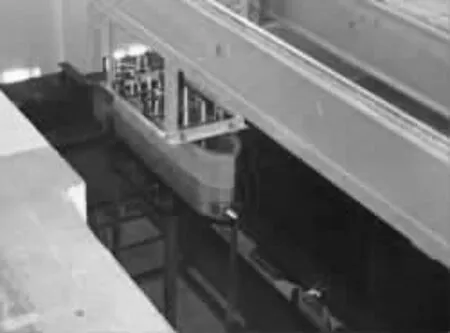
Fig.1 Towing carriage and open water tank
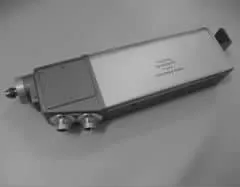
Fig.2 Self-propulsion instrument(Germany)
The propeller section in this experiment is independently researched.The main geometrical parameters of propeller are shown in Tab.1.The propeller rotational speed is 20 rps.The advance coefficient J(0.1~0.7)is changed by changing the inflow velocity.Tab.2 shows the location parameters of the open water tank in the experiment,where Hsis the depth of propeller shaft,that is the vertical distance from propeller centerline to water surface;D is the propeller diameter;Zhis the height from the bottom of open water tank to propeller shaft;H is the height of open water tank;Hhis the height from propeller axis to the top of open water tank and Hsis the height from water surface to the top of open water tank.Tab.3 shows the regular wave parameters used in this experiment(two-parameter spectrum of ITTC),where Awis amplitude;Hwis the wave height;λ is the wave length,and T is the wave period.

Tab.1 Main geometrical parameters of propeller

Tab.2 Main experiment parameters

Tab.3 Wave parameters
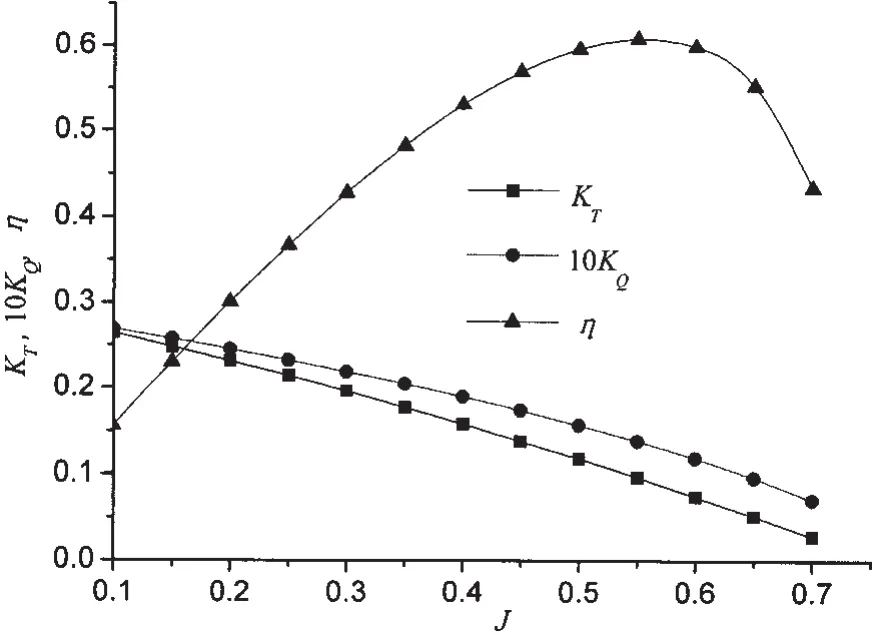
Fig.3 The open water characteristics curves of propeller
3 The experimental study of propeller hydrodynamic performance in calm waves
3.1 The open water performance test of propeller
The dimensionless parameters KTand KQshown below are used to represent the thrust and the torque changing with the advance coefficient J.
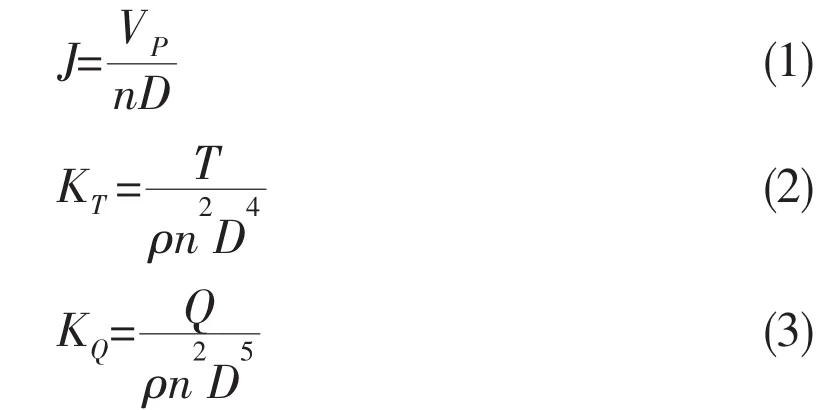

where T is the propeller thrust.Q is the propeller torque;n is the rotational speed of propeller.D is the diameter of propeller,and Vpis the advance speed of propeller(the forward velocity of towing carriage).The sink depth of propeller shaft is 1.5D in calm water(the enough sink depth can eliminate the impact of water surface).
Fig.3 shows the open water characteristics of propeller.
3.2 Influence of propeller hydrodynamic performance with varying depth of propeller shaft
In varying depth of shaft experiment,there are four different shaft depths(hs/D):1.5,1.2,0.8 and 0.6.The propeller thrust and torque coefficient in different sink depth conditions are compared with those in open water conditions,in which the propeller shaft is deep enough.The water temperature is 15 degrees.

Fig.4 Propeller thrust coefficients at different depths of propeller shaft

Fig.5 Propeller torque coefficients at different depths of propeller shaft
The propeller thrust and torque coefficients curves and efficiency curves at different depths of shaft are shown in Fig.4,Fig.5 and Fig.6.The air-ingesting phenomena are shown in Fig.7 and Fig.8.By analyzing those curves,we can conclude that:
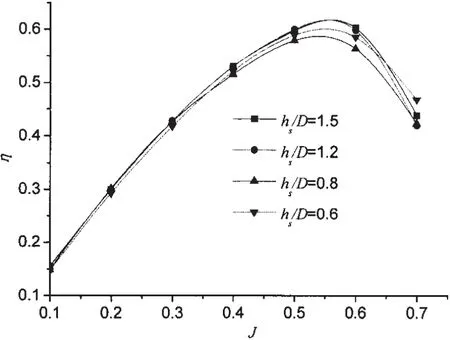
Fig.6 Efficiency curves at different depths of propeller shaft
(1)Depth of propeller shaft has much more influence on propeller thrust coefficient when the advance coefficient is small.As the advance coefficient increases,the influence decreases gradually.From Fig.4,we can see that the depth of shaft has great influence on propeller thrust coefficient in bollard conditions.When hs/D=0.6,the thrust coefficient is half of that when hs/D=1.5.Therefore,the experiment needs paying more attention to the shaft depth of propeller in bollard conditions.Meanwhile,when the depth of shaft is small enough,there is intense air-ingestion phenomenon,which makes the propeller thrust coefficient reduce significantly.

Fig.7 Air-ingestion phenomenon of propeller(hs/D=0.8)

Fig.8 Air-ingestion phenomenon of propeller(hs/D=0.6)
(2)The impact of shaft depth on propeller torque coefficient is similar to that on propeller thrust coefficient.When the advance coefficient is small,different depths of shaft have big impact on the torque coefficient.As the advance coefficient increases,this impact decreases.As shown in Fig.5,we can see that the impact of shaft depth on propeller’s torque coefficient is great in bollard conditions.We can predicate that the phenomenon is directly related to the air-ingestion in water surface.
(3)The advance coefficient corresponding to the optimal open water efficiency of propeller does not change if the depth of shaft changes.As shown in Fig.6,it can be seen that the efficiency does not have great gap with different depths of shaft when the advance coefficient is small.The propeller optimal open water efficiency decreases as the depth of shaft reduces.
(4)In this experiment,the propeller hydrodynamic performance while hs/D=1.2 is almost the same as that when hs/D=1.5,so we can consider that the depth of shaft has less influence to the propeller hydrodynamic performance when hs/D is larger than 1.2.But we find that even when hs/D is 1.2,there is air-ingestion phenomenon on water surface.We can regard that the depth of shaft hs/D≥1.0 recommended by ITTC in 1978 may be not enough when the advance coefficient is much smaller.
(5)Air-ingestion phenomenon seems more obvious when the advance coefficient is small in the test(the speed of towing carriage is small).It can also explain the depth of shaft is the main influence factor on propeller thrust and torque coefficient when advance coefficient is small.
4 The propeller hydrodynamic performance in waves
In the propeller hydrodynamic performance in regular waves experiment,there are three different depths of shaft(hs/D):1.2,0.8 and 0.6.In this experiment,the water temperature is 15 degrees.The regular wave adopts regular wave parameters(two-parameter spectrum by ITTC),and the wave length is 5.5 m.
Propeller thrust coefficients,torque coefficients and efficiency at different depths of shaft in calm water and regular waves are shown in Fig.9,Fig.10 and Fig.11.The effluent and spatter phenomenon of propeller are shown in Figs.12 and 13.By analyzing those figures,we can conclude that:
(1)The impact of shaft depth on propeller hydrodynamic performance in waves is similar to that in calm water.As the depth of shaft decreases,the propeller thrust and torque coefficient also decrease.When the advance coefficient is small,the depth of shaft has bigger impact on propeller thrust coefficients than torque coefficients.As the advance coefficient increases,the impact decreases gradually.

Fig.9 Propeller thrust coefficients at different depths of shaft in calm water and regular waves

Fig.10 Propeller torque coefficients at different depths of shaft in calm water and regular waves
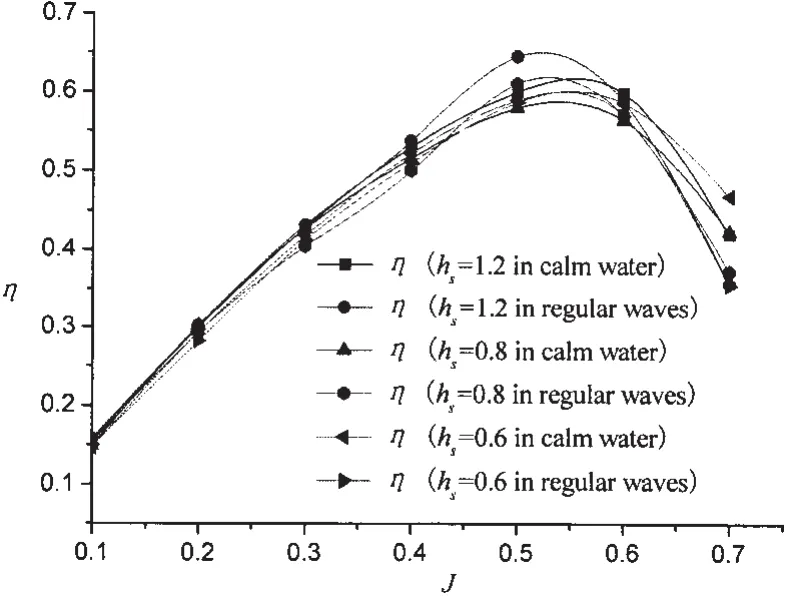
Fig.11 Propeller efficiency of different depths of shaft in calm water and regular waves

Fig.12 The effluent and spatter phenomenon of propeller(hs/D=0.8)

Fig.13 The effluent and spatter phenomenon of propeller(hs/D=0.6)
(2)The propeller thrust and torque coefficients in waves change less compared with in calm water when hs/D is 1.2,but the optimal open water efficiency in waves is even better than that in calm water.After the optimal efficiency point,the propeller thrust and torque coefficients decline much faster.
(3)The propeller thrust coefficients and torque coefficients are smaller compared with those in calm water when hs/D is 0.8.Especially when the advance coefficient is small,the difference is much bigger,and the difference becomes smaller as the advance coefficient increases.The maximal open water efficiency is better in waves.
(4)It can be seen from the figures that when hs/D is 0.6,the propeller thrust and torque coefficient curves in waves and in open water become across.When advance coefficient is smaller than 0.13,both the propeller thrust and torque coefficient in waves are larger than those in calm water;and when the advance coefficient is bigger than 0.13,both the propeller thrust and torque coefficient in waves are less than those in calm water.When hs/D is 0.6,the propeller efficiency in waves is nearly the same as the efficiency in calm water before maximal efficiency point.After the maximal efficiency point,the propeller efficiency in waves declines faster.
(5)It can be seen that even in waves,the position of the optimal efficiency point does not change.So in waves conditions,the basic characteristics of the propeller will not change.
(6)Seen from the experiment process,the spatter phenomenon in waves associated with air-ingestion phenomenon will impact propeller hydrodynamic performance.Ships in sea conditions can not avoid the water surface and wave affection.Especially for shallow draft ships,the impact is huge and should be paid enough attention.
5 Unsteady characteristics of propeller in waves
Next,unsteady characteristics of the propeller at different depth under waves conditions are going to be studied.It needs to be illustrated that both thrust and torque coefficient of propeller in the above two chapters are time average value.It is known that even a propeller runs under a condition that is deep enough and in still water,the thrust and torque coefficients should be unsteady period value which are coincident with blade frequency,but the changing amplitude is small(2%~3%).But if the propeller works in waves conditions,the unsteady characteristics of hydrodynamic performance would be much more important.Strictly speaking,it is not enough considering only one period.The unsteady characteristics of propeller working in waves conditions with propeller shaft depth hs/D=0.8 are going to be analyzed.In Fig.14,it shows the change of thrust coefficient KT,torque coefficient KQand the real-time wave height Awalong with the time in different velocities.By analyzing those figures,we can conclude that:
(1)Unsteady characteristics of the propeller(both thrust and torque)are very visible under waves conditions.The changing amplitude of the thrust and torque coefficient is much larger,and the unsteady bearing force is obvious,so the unsteady features can not be ignored when analyzing the propeller’s unsteady characteristics under waves conditions.At the same time,the strength checking should also consider the unsteady features.
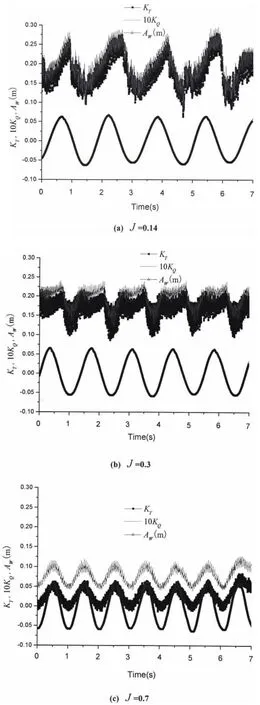
Fig.14 Unsteady characteristics of propeller in waves(hs/D=0.8)
(2)The unsteady period of propeller is coincident with wave period for the existence of regular wave.The minimum of thrust and torque appears in wave trough,and the maximum of thrust and torque appears in wave chest.
(3)The periodicity of the thrust and torque coefficient changes smoothly when the advance velocity is bigger,but the periodicity changes violently when the advance velocity is smaller.It can be concluded that the propeller shaft bears much more unsteady force at small advance velocity.
6 Concluding remarks
Based on the experimental analyses of propeller hydrodynamic performance in calm water and waves,we can conclude that:
(1)By comparing the propeller hydrodynamic performance in waves with that in calm water,it is not accurate to simply say that the propeller propulsive efficiency reduces in waves.
(2)The important reason of the propeller hydrodynamics performance change is the effluent and spatter phenomenon caused by decreasing the depth of shaft.
(3)The unsteady characteristics of propeller in waves are very important.The changing amplitude of the thrust and torque coefficient is much larger,and the unsteady bearing force is obvious,so the unsteady features can not be ignored when analyzing the propeller’s unsteady characteristics under waves conditions.
(4)For the limitation of existence conditions,there may be some bias in the experiment process,such as the height problem of the propeller open water tank,the levelness and gradient of the open water tank,etc.All of them could affect the experiment.
(5)In the experiment the regular wave parameters are fixed.Some further researches still need to be done about propeller performance in irregular and regular wave’s parameters.
[1]Yuasa,Hajme.Calculation of the fluctuations of propeller load induced by ship motions in oblique waves(Part 1)[J].Journal of the Society of Naval Architects of Japan,1974(136):69-82.
[2]Nakama,Natio,et al.Open-water characteristics and load fluctuations of propeller in waves[J].J of Kansai Soc of Naval Arch.,Japan,1975(159):41-55.
[3]Faltinsen O M.Prediction of resistance and propulsion of a ship in a seaway[C]//13th Symposium on Naval Hydrodynamics.Tokyo,1980.
[4]Nakatake K,Yamazaki R.Effect of the free surface on the propulsive performance of a ship[J].Journal of the Naval Architects of Japan,1984(68):45-58.
[5]Wang Guoqiang,Jia Dashan.Influence of free surface on propeller characteristics[J].Shipbuilding of China,1986(1):1-8.
[6]Tao Yaosen,Ding Hao,Feng Tiecheng.An approximation method for calculating thrust variation of propeller in waves[J].Journal of Ship Mechanics,1999,3(5):1-6.
[7]Ding Hao.The prediction of propeller’s performance and stall in waves[D].Shanghai:The Master Dissertation of Shanghai Jiao Tong University,1998.
[8]Liang Qianchao,Wan Lin.A method for calculating the hydrodynamic changes of propeller in waves[J].Ship Science and Technology,2006,28(4):32-35.
[9]Yu Xin.Research on hydrodynamic performance of propeller in heaving conditions[D].Harbin:The Master Dissertation of Harbin Engineering University,2008.
[10]Natio,Nakama,et al.Open-water characteristics and load fluctuations of propeller at racing conditions In waves[J].J of Kansai Soc of Naval Arch.,Japan,1979(172):51-63.
[11]Lee C S.Propeller in wave-state of the art[C]//2nd PRADS.Tokyo,1983:139-148.
[12]Jia Dashan,Wang Guoqiang,Cao Meiliang.Air ventilation and hydrodynamic performance of propeller[J].Journal of Shanghai Jiao Tong University,1990,24(4):32-41.
[13]Cao Meiliang.The open-water characteristics of a propeller with varying depth of shaft and in waves[J].Journal of Shanghai Jiao Tong University,1988,22(3):27-35.
[14]Tao Yaosen,Zhou Xiangyang.The self-propelled factors and stall phenomenon of hooker in waves[J].Shipbuilding Engineering,1984(3):24-32.
[15]Tao Yaosen,Zhang Fan,Feng Tiecheng.A study on propeller thrust and torque increase in regular waves[J].Shipbuilding of China,1991(1):47-57.
- 船舶力学的其它文章
- Experimental Study of the Motion Responses of a Large Mooring(LNG)Ship in the Waves with Grand Period
- CLSVOF Method for Violent Sloshing with Impact Load in Tanks under Shallow Water Depth
- A New Method for Predicting the Steady Performance of Ducted Propeller with Stators
- Research on Method for Optimization Design of Riblets Angle based on CFD Techniques
- Online Prediction of Ship Rolling based on Varying Parameters LSSVM
- In-line Dynamic Characteristic of a Circular Cylinder under Vortex-induced Vibration

